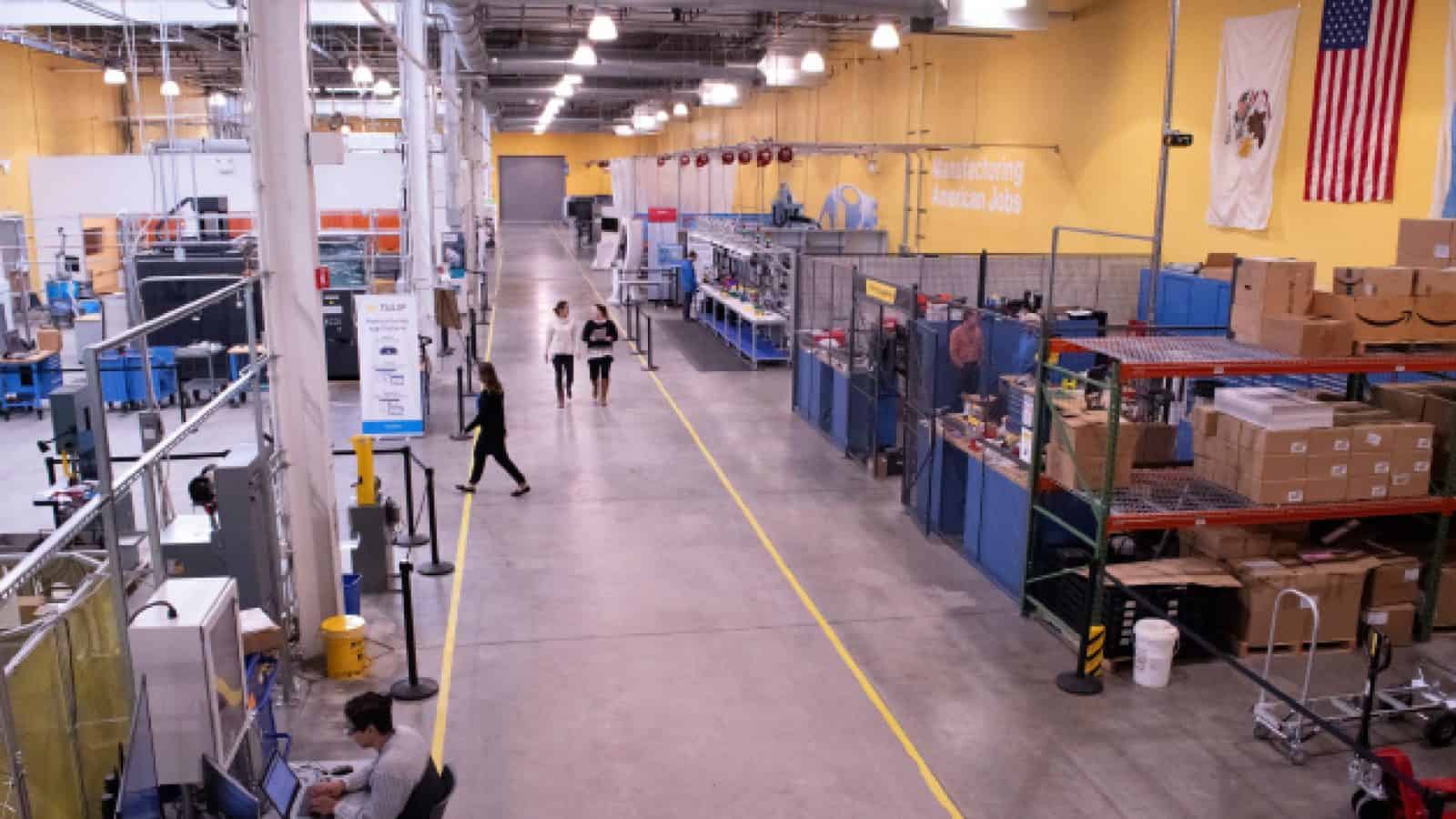Three Strategies to Mitigate the Manufacturing Skills Gap

To mitigate an acute labor shortage, manufacturers can source local talent, develop internal talent, or create partnerships to grow talent externally.
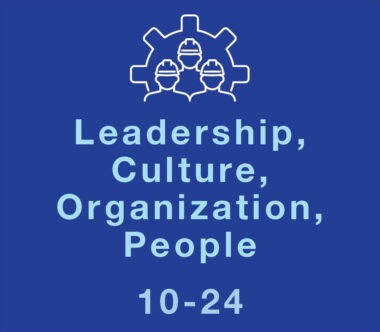
TAKEAWAYS:
● Manufacturers can achieve cost savings and realize operational benefits by developing strategies to recruit and retain local talent.
● Companies can develop robust “in house” training programs to develop much-needed skills, but such initiatives require significant time and money.
● By managing the skills gap through external collaborative public-private partnerships, manufacturers can build a talent pipeline for near-term and long-term needs.
A recent study by Deloitte and the Manufacturing Institute indicated that the manufacturing skills gap could result in 2.1 million unfilled jobs by 2030, representing a cost of $1 trillion in 2030 alone. From a manufacturing perspective, the skills gap is generally defined as the inability to find workers who have the manual, operational, and highly technical skills, knowledge, or expertise to fill open positions. However, the manufacturing skills gap is a problem that many manufacturers are not only anticipating for the future, but they are also facing today. The ability to recruit manufacturing talent at all levels and retain that talent is at the forefront of problem-solving for many global manufacturers.
Companies have started to develop many strategies to mitigate the risks of the skills gap. From increased automation to changes in immigration policies, companies are working to develop solutions to ensure they have the workforce required for their production lines. JLL’s site selection and location strategy team has helped clients navigate the complexities of global labor markets. We highlight three strategies that can help solve immediate labor market shortages and develop a pipeline of talent to shrink the anticipated gap:
- Find Local Talent: Companies derive immense strategic value when they identify areas that have the specific types of talent they need for a production process and then locate operations there. By developing strategies to recruit and retain local talent, companies can realize massive financial savings and operational benefits.
- Develop Talent Internally: Many companies seek to develop manufacturing skills internally through internal training programs, especially when a local market cannot supply sufficient talent or a specific type of talent.
- Grow Talent Externally: As a complementary option to the first two strategies, manufacturers can enhance collaborations with local communities, community colleges, technical schools, and universities to proactively develop the skills they will need and build a pipeline of talent for the future.
Find Local Talent
Labor markets across the U.S. and the world are inherently different and no two markets have the same size and composition of skills. Each labor market also has an existing ecosystem of manufacturers that create a unique competitive environment for talent. Manufacturers can strategically locate in markets with large volumes and deep concentrations of the skills their production process requires. This strategy also requires an understanding of the existing demand for that talent to ensure a company can both recruit and retain talent. While companies can use many published sources to understand the supply side of talent markets, the demand side often requires in-person interviews with local subject matter experts.
As an example, highly automated manufacturing processes that employ mainly skilled technicians and engineers will want to locate to labor markets with deep pools of technical talent. In contrast, a more manual production process that can hire lower-skilled employees does not need to locate to the same technical labor market but could seek a talent market with more general manufacturing skills.
According to EMSI Lightcast, the current highest in-demand jobs in manufacturing include maintenance technicians, machine operators, material handlers, and forklift drivers. When looking into the future, most studies suggest that the in-demand manufacturing jobs will have an increased focus on engineering, technology, and robotics. Job titles such as machine operator, production technician, and process engineer are just a few of the jobs that will grow in demand and technological complexity (Table 1).
Table 1: Most In-Demand Manufacturing Jobs (August 2023–July 2024)
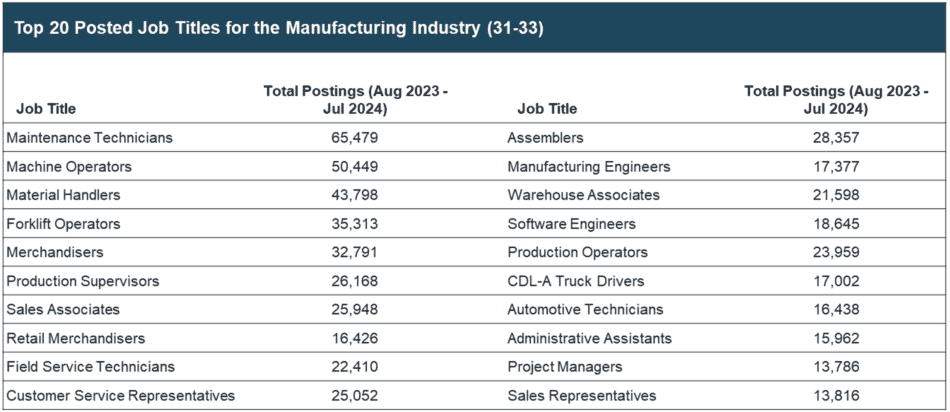
To illustrate the differences between labor markets, consider the two highest in-demand jobs––maintenance technicians and machine operators. For maintenance technicians, large volumes of talent exist in all major metropolitan areas, but there are relatively few large metro areas that also have a large concentration of that talent (meaning high proportion of maintenance technicians as compared to the national average). Stand-out markets include Houston and Detroit, which have typically been dominated by the oil & gas and automotive industries. What the supply-side data do not illustrate is that the level of competition in both these markets is very high (Figure 1). As an example, recent interviews with local recruiters in Houston indicated that nearly all maintenance technicians are employed by local energy companies that offer above market salaries and are nearly impossible to compete against.
Figure 1: Maintenance Technician Volume & LQ by MSA


In contrast, the landscape for machine operators is more concentrated in the Midwest. These markets have typically been dominated by the automative industry for decades and have developed a large volume of skilled operators. Also, the automotive industry and manufacturing in general have been the largest employers in the region, giving these markets high concentrations of machine operator talent as well. Stand-out markets include Detroit, Cleveland, Grand Rapids, and Milwaukee. While the supply-side view of the data do not provide any insight on the competitive nature in those markets, recent interviews indicate a generally lower level of competition in many of the Midwest’s legacy manufacturing markets (Figure 2).
Figure 2: Machine Operators Volume & LQ by MSA

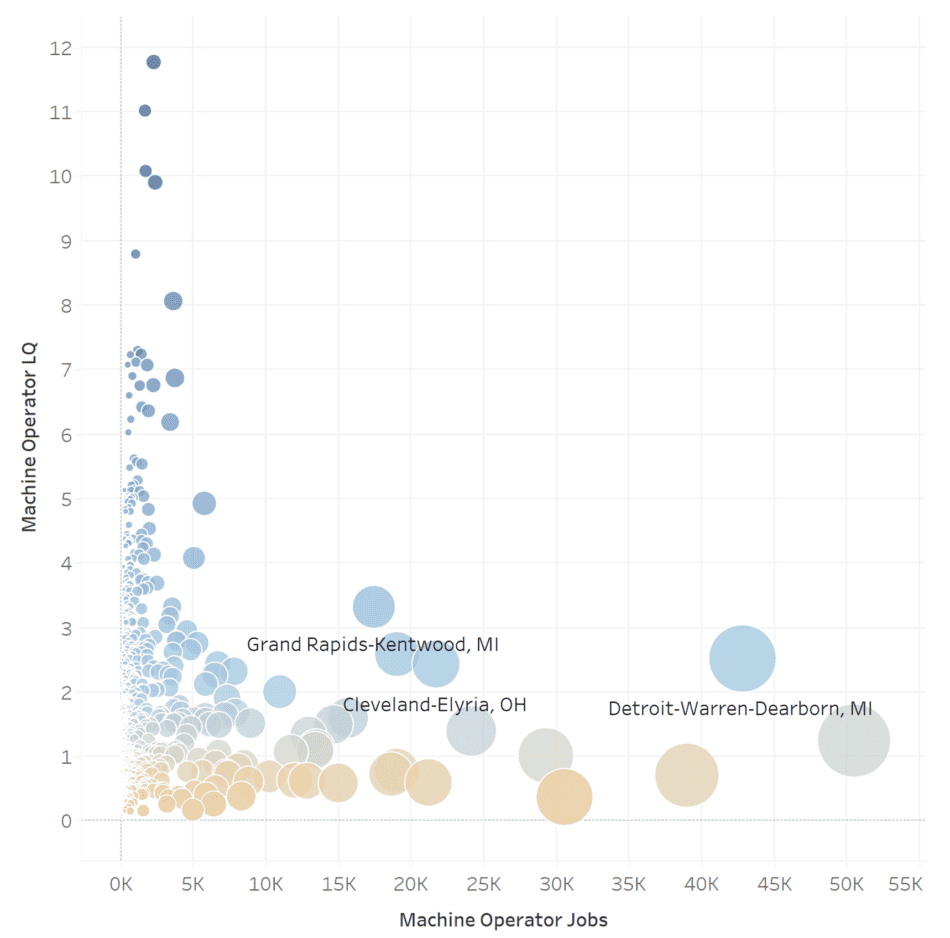
Once manufacturers identify a market that has a good alignment between the skills they require and those that are available locally, they need to develop a robust recruitment and retention plan to ensure the ability to hire and keep that talent. These strategies include shortened hiring times, streamlined interview processes, competitive compensation packages, first-line supervisor leadership training, and flexible work schedules, to name a few.
Develop Talent Internally
Internal training has become a growing standard among manufacturers that need specific skills that they cannot recruit locally, or even nationally. Many skills, such as the maintenance technician, are in high demand in nearly every market across the U.S., creating a nationwide shortage that cannot be solved by location strategy alone. Internal training for these highly skilled positions, or even lower-skilled positions, enable manufacturers to enlarge the recruitment catchment pool by removing specific skills, education, and/or years of experience requirements. Companies then focus on developing robust internal training programs to cultivate the skills they need, whether that is general production operator skills training or more robust maintenance technician apprentice programs.
Consider this example: If a manufacturer were seeking to hire CNC programmers, the national labor pool is 29,010. At the entry level, a CNC programmer typically requires a certificate or associate’s degree and 2–3 years of experience. Should a manufacturer widen its search and seek to employ CNC operators and train them internally to be programmers, the total labor pool would increase to 218,362 (Table 2). Moreover, if a manufacturer were willing to spend additional training time it could broaden its recruitment pool to include general machinists and machine operators, increasing the total talent pool to over 1.7 million potential candidates nationally.
Table 2: Volume of CNC Programmers and Related Occupations
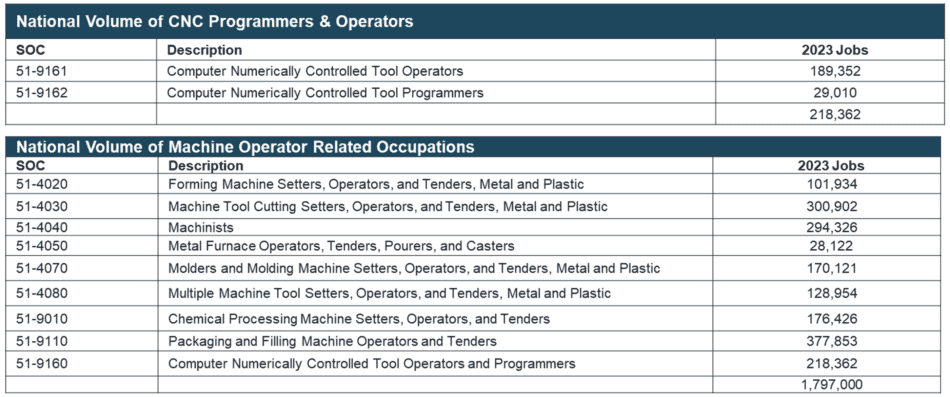
This approach, while generally effective, requires both a long lead time and a large capital expenditure to create the classroom environment and on-the-job training conditions required to train complex skills. Also, some training will require 2–3 years, and manufacturers will need to plan sufficiently for the long lead time required to train in-house. Moreover, the investment of time, money, and resources will require manufacturers to look at retention plans and work to maximize employee engagement and retention so that the capital invested to train candidates does not end up elsewhere once they complete training.
Grow Talent Externally
A third strategy to managing the skills gap is through collaborative public-private partnerships between manufacturers, local community colleges or technical colleges, universities, and local economic development agencies to proactively develop training programs and curriculum to support the skills required by the manufacturing industry. This approach applies to both the skills needed in the near term, and those anticipated into the future. Many examples exist in which local communities and higher education institutes directly influence the volume and quality of candidates that enter the labor market. This approach to skills development plays a critical role in developing a talent pipeline, sometimes across generations, as many communities are introducing manufacturing skills and education as early as the primary school level.
Finding communities that have either made or are willing to make a notable investment in technical training programs either through existing community colleges or training institutes is a good starting point to solving the skills gap challenge. Often it is easier to incrementally enhance an existing skills training program than start from scratch with an entirely new initiative. In fact, many states and local communities are extremely proactive, forward thinking, and collaborative, and are willing to make the necessary investments to enhance the talent pipeline supporting a community.
The map below highlights the volume of graduates from maintenance repair-related programs (either associate’s degrees or certificate programs) (Figure 3). Phoenix has the large volume of graduates (5,000+), followed by Los Angeles, Chicago, Atlanta, Dallas, and Houston.
Figure 3: 2023–2023 Maintenance Repair-Related Programs
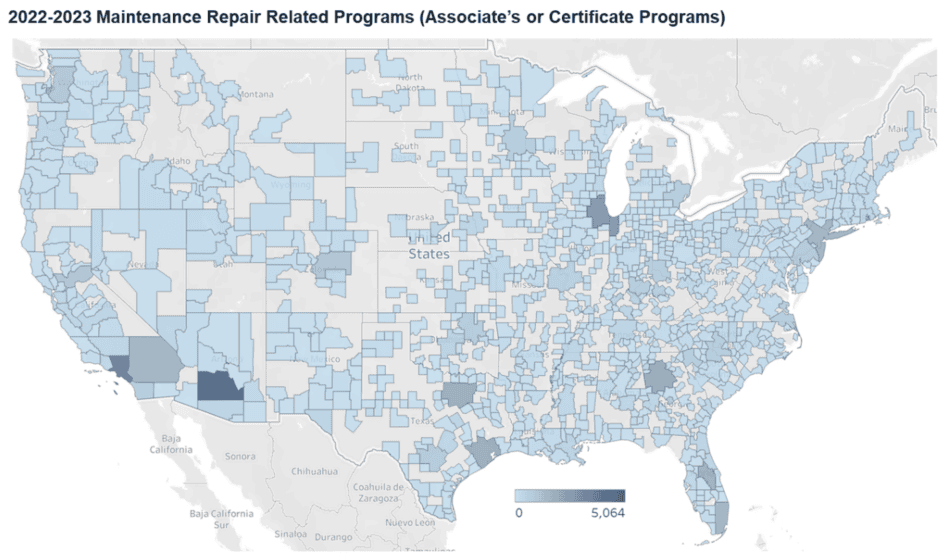
Conclusion
The skills gap is a current and future problem with massive consequences for the U.S. manufacturing industry. The need to find immediate solutions while also developing strategies to mitigate future difficulties has driven many manufacturers to turn significant focus on their “people operations.” Whether companies choose to locate (or relocate) their operations into a specific labor market, develop internal training programs to fill local skills shortages, partner with local communities to develop a pipeline of manufacturing talent, or use other strategies, the need to proactively solution around a nationwide shortage of manufacturing skills exists for most companies across the manufacturing industry. Manufacturers that proactively work to develop solutions are likely to gain significant advantage in an increasingly tight national labor market. M
About the authors:

Shannon Curley is executive managing director, Business Consulting at JLL.

Matt Jackson is executive managing director, Business Consulting at JLL.
